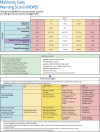Development of a national maternity early warning score: centile based score development and Delphi informed escalation pathways
- PMID: 38756669
- PMCID: PMC11097818
- DOI: 10.1136/bmjmed-2023-000748
Development of a national maternity early warning score: centile based score development and Delphi informed escalation pathways
Abstract
Objective: To derive a new maternity early warning score (MEWS) from prospectively collected data on maternity vital signs and to design clinical response pathways with a Delphi consensus exercise.
Design: Centile based score development and Delphi informed escalation pathways.
Setting: Pregnancy Physiology Pattern Prediction (4P) prospective UK cohort study, 1 August 2012 to 28 December 2016.
Participants: Pregnant people from the 4P study, recruited before 20 weeks' gestation at three UK maternity centres (Oxford, Newcastle, and London). 841, 998, and 889 women provided data in the early antenatal, antenatal, and postnatal periods.
Main outcome measures: Development of a new national MEWS, assigning numerical weights to measurements in the lower and upper extremes of distributions of individual vital signs from the 4P prospective cohort study. Comparison of escalation rates of the new national MEWS with the Scottish and Irish MEWS systems from 18 to 40 weeks' gestation. Delphi consensus exercise to agree clinical responses to raised scores.
Results: A new national MEWS was developed by assigning numerical weights to measurements in the lower and upper extremes (5%, 1%) of distributions of vital signs, except for oxygen saturation where lower centiles (10%, 2%) were used. For the new national MEWS, in a healthy population, 56% of observation sets resulted in a total score of 0 points, 26% a score of 1 point, 12% a score of 2 points, and 18% a score of ≥2 points (escalation of care is triggered at a total score of ≥2 points). Corresponding values for the Irish MEWS were 37%, 25%, 22%, and 38%, respectively; and for the Scottish MEWS, 50%, 18%, 21%, and 32%, respectively. All three MEWS were similar at the beginning of pregnancy, averaging 0.7-0.9 points. The new national MEWS had a lower mean score for the rest of pregnancy, with the mean score broadly constant (0.6-0.8 points). The new national MEWS had an even distribution of healthy population alerts across the antenatal period. In the postnatal period, heart rate threshold values were adjusted to align with postnatal changes. The centile based score derivation approach meant that each vital sign component in the new national MEWS had a similar alert rate. Suggested clinical responses to different MEWS values were agreed by consensus of an independent expert panel.
Conclusions: The centile based MEWS alerted escalation of care evenly across the antenatal period in a healthy population, while reducing alerts in healthy women compared with other MEWS systems. How well the tool predicted adverse outcomes, however, was not assessed and therefore external validation studies in large datasets are needed. Unlike other MEWS systems, the new national MEWS was developed with prospectively collected data on vital signs and used a systematic, expert informed process to design an associated escalation protocol.
Keywords: Critical care; Obstetrics; Pregnancy complications.
© Author(s) (or their employer(s)) 2024. Re-use permitted under CC BY. Published by BMJ.
Conflict of interest statement
Competing interests: All authors have completed the ICMJE uniform disclosure form at www.icmje.org/disclosure-of-interest/ and declare: the Pregnancy Physiology Pattern Prediction (4P) study was funded by the National Institute for Health and Care Research (NIHR) and Oxford Biomedical Research Centre; MK is an NIHR senior investigator (NIHR201333); no financial relationships with any organisations that might have an interest in the submitted work in the previous three years; no other relationships or activities that could appear to have influenced the submitted work. The NIHR have had no input into the content of the manuscript.
Figures




References
-
- Health Improvement Scotland . The Scottish maternity early warning system (MEWS). 2021. Available: https://ihub.scot/media/7739/scottish-clinical-guide-national-mews.pdf
LinkOut - more resources
Full Text Sources
